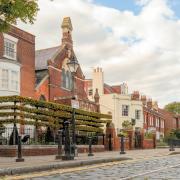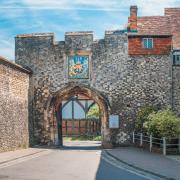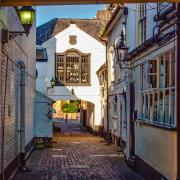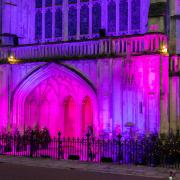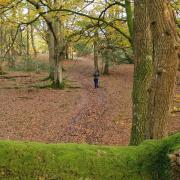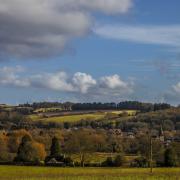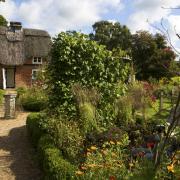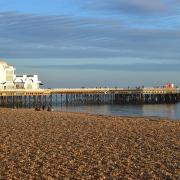Hampshire's strangest and quirkiest places are waiting to be explored, if you just know where to look says Faith Eckersall
Beware chalk pit
The above must be the strangest name ever given to a racing horse but it’s not so strange when you discover the story behind the iconic white structure at Farley Mount, west of Winchester.
The folly is a monument to the steed which belonged to Paulet St John, the 3rd Earl of Bolingbroke. He rode it to victory in 1734 - just one year after the beast had plunged into a chalk pit and survived.
The inscription on the plaque on the building’s north wall reads: ‘Underneath lies buried a horse, the property of Paulet St. John Esq, that in the month of September 1733 leaped into a chalk pit twenty-five feet deep, afoxhunting with his master on his back and in October 1734 he won the Hunters Plate on Worthy Downs and was rode by his owner and was entered in the name of Beware Chalk Pit.’
Visitors may be more interested in the views from the monument, which is easy to see as its white walls reflect the sun for miles, from what is one of the highest hills in Hampshire.

Step in to a work of art
Don’t be fooled by Sandham Memorial Chapel’s utilitarian, brick exterior. Designed by Lionel Pearson and now Grade II listed, it is merely the shell for what is easily one of the UK’s greatest art experiences – the series of 19 paintings by Sir Stanley Spencer, depicting his military experiences in the First World War.
Even the fabled architecture expert, Nikolaus Pevsner, was impressed, describing the Burghclere chapel building as: ‘The outstanding English monument to painting of the pioneering years.’
The breathtaking work inside took six years to complete and show Spencer’s time as a medical orderly, his time in Macedonia and at the Beaufort Hospital in Bristol. The most famous part of the mural is Spencer’s Resurrection, which nods to the horror of war.

From pirates to pints
It’s the home of the Dancing Man Brewery in Southampton now, but it’s not hard to guess from its handsome stone façade, that The Wool House on Town Quay is really a bit special.
Built in the 12th century after what is believed to have been a pirate raid, the building stored wool destined for export to Europe and continued in this capacity until the 16th century, when it was used to store alum, a rock which had many industrial uses.
French prisoners from the Napoleonic Wars were kept there in the 18th century, carving their names into the woodwork, presumably to relieve the boredom of their captivity. Later, in the early 20th century, the Moon engineering family took it over, using the space for boat-making and to perfect their plane, Moonbeam II, which eventually flew from Southampton airport.
It’s been the town’s maritime museum, it’s been mentioned in Pevsner, it’s been Listed since 1953 and viewing it couldn’t be simpler – just pop in for a crafty pint!

A house made from shells
Based on the design of the Chichester Cross, the Shell House at Leigh Park gardens has been delighting visitors young and old since it was built in 1828 for its owner, Sir George Thomas Staunton.
The hexagonal structure was constructed from Hampshire flints and decorated with seashells gathered on Hayling Island. Visitors who take time to peek through the windows can see that inside, it’s still a home for the plaques commemorating Sir George’s family and in the past it was used to store such eclectic treasures as a stuffed crocodile, crystals and a Toucan bill.

The church over a gate
Look up as you walk beneath Kingsgate in Winchester because you’re actually standing underneath a church!
St Swithun upon Kingsgate was built during the Middle Ages and actually forms part of the old city walls. First mentioned in 1264 – after it was burned by furious city residents over a dispute with the Priory – documents show it underwent window repairs in 1484.
It’s named after the saint who became synonymous with Winchester. Swithun was born in the city in 852 and became its 19th bishop as well as possibly becoming a tutor to King Alfred the Great.
His eponymous church suffered a chequered career, falling out of favour during the Reformation and at one time even becoming a residential home.
Its reputation was restored in the 19th century when the writer Anthony Trollope re-named it St Cuthberts and used it as the church in his novel The Warden. Trollope wrote: ‘The church is a singular little Gothic building, perched over a gateway, through which the Close is entered, and is approached by a flight of stone steps which leads down under the archway of the gate. It is no bigger than an ordinary room, perhaps 27 feet long by eighteen wide - but still a perfect church.’

The original Swiss Cottage
Just over the Solent on the Isle of Wight stands what must be one of the region’s most enchanting buildings.
Prince Albert built the Swiss Cottage in the grounds of Osborne House as a place where his children could learn how to cook, garden and run a home. Everything was made to three-quarter, child-sized scale, and in keeping with Albert’s philosophy, the two oldest princes, Bertie and Alfred, helped lay its foundations and were believed to have been paid a wage for their labours.
The Alpine-style building was completed in 1854 and adored by the Royal Family, who were often entertained there by their children. But it’s also a house with a secret. Researchers knew the Royal children had used or worked in their own dairy but never found the room. The space was re-discovered by English Heritage researchers after a new look at the house’s plans lead to the unblocking of a door which had been plastered over to reveal the lost dairy.

The abandoned country pile
With its Greek Revival columns and gracious layout, it’s hard to believe The Grange, at Northington near Winchester, was once earmarked for demolition.
It’s also hard to believe that it started life as a relatively modest building made from brick in the 17th century, and was transformed by architect William Wilkins between 1809 and 1816. He literally wrapped it in concrete to create its classic Greek temple look, complete with Doric columns.
In 1933 The Grange, which had seen visits from such illustrious visitors as King George IV, was sold, and during the Second World War it was occupied by the Army.
In the late 1960s its owners obtained permission to demolish the building, reportedly using dynamite. Happily, there was a public outcry and the property was taken over by the state in 1978, saving its conservatory as well as the main structure.
Today it’s used to stage operas and it was Grange Park Opera which bought back the building’s staircase, which had been removed during the 1970s, restoring some, at least, of its grandeur.





